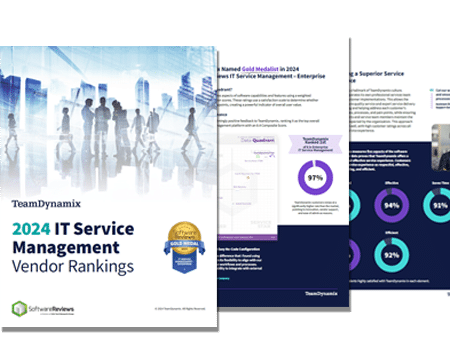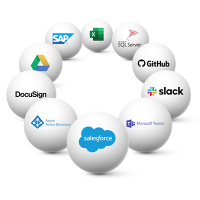
Improving Communication, Self-Service with a One-Platform Approach
As technology has evolved for different parts of an organization, so have the technology stacks for departments like IT, HR, marketing and more. And as

The Info-Tech ranking report offers a unique view of the market based entirely on in-depth customer interviews. Download the Info-Tech ITSM Quadrant and Customer Viewpoint report today.

We’ll show you some of our best situations and show you exactly how to execute them to get immediate results. The best part is, iPaaS tools often feature easy-to-use click and drag functionality, meaning you don’t need a dedicated employee building integrations and workflows.

System Integrators, Value Added Resellers, Technology Providers, and Buying Consortiums can benefit from a partnership with TeamDynamix.

The Info-Tech ranking report offers a unique view of the market based entirely on in-depth customer interviews. Download the Info-Tech ITSM Quadrant and Customer Viewpoint report to gain a better understanding of key vendor strengths and emerging market requirements.
As banks and other financial institutions continue to modernize and meet the needs of customers who want 24/7 service and robust banking apps – many are struggling with outdated ITSM technology, low levels of automation and inefficient project management capabilities.
TeamDynamix recently partnered with InformationWeek to conduct a study around the IT Service Management needs of the financial services industry and found that 45 percent of financial services companies say they struggle with moderately low to very low ITSM maturity. In addition, 43 percent of those surveyed said their top challenge in ITSM is excessive manual processing or insufficient automation.
In fact, 60 percent of respondents said their IT teams spend 5 or more hours per week on repetitive manual tasks. And when you consider that 54 percent say they are using an ITSM platform that is five or more years old – the lack of automation isn’t surprising.
As more and more companies are pushing to modernize their legacy technology – automation is playing a big role. This is also reflected in the study, with 50 percent of respondents saying automation is their top IT objective.
Customers have high expectations for top-notch fintech capabilities – and no matter the size or scope of your financial institution, this holds true.
Constantly shifting business requirements in this era of digital transformation has accelerated the rate of change that financial services must maintain in their IT services and processes in order to keep ahead of market trends. At the same, financial organizations have to balance these customer expectations and constantly evolving IT needs amid a landscape of always-shifting compliance and regulation requirements.
In addition, these customer-facing apps and other bleeding-edge technologies are often built right on top of, or alongside aging legacy technology. This can cause disconnect throughout an organization as IT struggles to keep up with aging infrastructure, limited resources, restrictive regulations and complex back-office processes – all while ticket volumes continue to grow.
According to the survey, almost 60 percent of financial services firms manage more than 500 tickets per month and more than 10 percent have a volume of over 5,000 tickets per month. Unfortunately, many financial services ITSM teams are called upon to deal with this heavy workload without sufficient automation or optimized workflows. In addition, financial services IT teams must maintain a growing number of applications and integrations with 40 percent of respondents saying they have to maintain support for 100 or more applications, and 13 percent saying they manage a staggering 400 or more applications.
When asked about the maturity of core ITSM capabilities, survey respondents ranked automation and workflow in sixth place out of seven. This offers a striking proof point: financial services firms have huge opportunities to take ITSM to the next level through smarter automation and refreshes of legacy systems.
Many banking and financial institutions pride themselves on being cutting-edge when it comes to technology, and often, to be on the cutting edge, you need to update internal legacy systems like your IT Service Management system, your project management software and processes, your HR systems, etc.
Frontwave Credit Union, a banking institution based in Oceanside, California, is embarking on a digital transformation and has dubbed this year the year of the process as it implements a digital-first strategy to improve the customer experience for both members and employees.
“This year is the year of the process, and that’s where we are really focused,” explained Roger Estrada, Vice President of Process Excellence and the Program Management Office. “We are meeting this increased demand (from customers) by restructuring what we do and how we do it by making our processes scalable, creating better escalation paths, providing self-service opportunities and prioritizing requests based on different criteria. But it all begins for us by really understanding our value stream and overall service flow.”
Estrada and his team work cross-functionally with IT, Operations, Finance and many other groups to support the respective team’s initiatives.
The process excellence initiative dovetails seamlessly with leadership’s digital-first vision.
When it comes to IT Service Management (ITSM), Estrada said the organization is hyper-focused on reviewing processes and ensuring there aren’t any non-value add steps that result in friction or a bad experience, “We want to make sure we’re properly set up to meet the needs and demands of our organization and our customers.”
To do this, his team engages with the IT organization to help uncover any areas for improvement. With the organizational focus on digital-first, Estrada is tasked with finding opportunities to support this vision. The PMO team is doing this by listening to the voice of the process, gathering data and analyzing it critically to really see where improvements can be made.
As an example, Estrada worked with IT leadership to identify areas where IT technicians were spending too many hours on manual work. “As we started evaluating our processes, we were seeing there are a lot of manual processes that cause a drain on our resources,” Estrada said. “We think we can get some positive results and benefits by introducing some automation.”
“Many IT teams are loaded down with service tickets, so we wanted to look at our processes and see where there are opportunities to automate ticket resolution and find ways to improve our ease of service,” Estrada said. “The quicker and easier it is to resolve tickets, the better the experience is.”
As part of this strategy, Frontwave made the switch to TeamDynamix as it offered a unified platform that encompasses IT Service Management, Project Portfolio Management (PPM) and enterprise integration and automation (iPaaS).
With a no-code platform, the team can reduce time spent on system administration and can roll out new functionality, workflows and integrations faster. As organizations seek to level up their key functions such as IT service delivery and to initiate digital transformation, many are requiring new technology solutions to be no-code.
“We have a lot of competing priorities so we really want to understand the team’s workflows and priorities so that we can continue to deliver the best customer experience,” he said.
With the influx of new tools and solutions being implemented to usher in a new digital experience and an evolution of user expectations to have fulfilling digital experiences – especially when it comes to customer service – it can be a real hornet’s nest for IT teams to manage.
A single platform approach, like the one Frontwave is using, allows IT leaders to engage in resource capacity planning to improve their technicians’ workloads and quality of life. Additional benefits of using a single platform for ITSM and PPM include:
Frontwave is also looking to automate manual tasks that bog down resources.
TeamDynamix can supercharge ITSM and PPM by integrating with enterprise systems, or it can be used to integrate any applications for data transfer and automation. This can include Workday, Salesforce, Teams, Slack, DocuSign, Office365 or any of the hundreds of solutions that make up an organization’s tech ecosystem.
“Our focus is really on improving our operational layer and looking to optimize with technology enhancements,” he said. “Our biggest focus is on delivering the best experience, products and service to our members.”
Curious to learn more about the state of IT within financial services? Check out the latest market study: State of ITSM in Financial Services.

As technology has evolved for different parts of an organization, so have the technology stacks for departments like IT, HR, marketing and more. And as

As a guiding framework, Information Technology Infrastructure Library (ITIL) functions to help IT keep pace with the organization’s needs and goals. With companies accelerating their digital

As an IT leader, managing multiple projects can be overwhelming, especially when they all have different priorities and timelines. This is where Project Portfolio Management
TeamDynamix’s award-winning SaaS cloud solution offers IT Service and Project Management together on one platform with enterprise integration and automation.
[email protected]
(877) 752-6196
Contact Us
